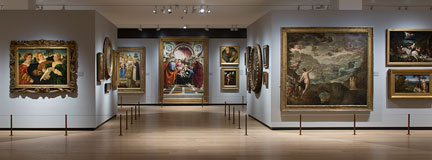Issued June 2014
Refurbished Gallery reopens to the public with a new display and longer opening hours
Following a two-year refurbishment, the National Gallery’s impressive gallery space, Room A, has reopened to the public. Lying beneath the main floor galleries, this permanent display offers visitors a chance to explore 218 pictures dating from the 13th to the late 19th centuries.

This newly reopened gallery offers a different way of experiencing the nation’s collection of European paintings as it is hung in broadly chronological order, telling the entire story of 400 years of painting in a single space. It aims to enhance visitors’ appreciation and understanding of some of the National Gallery’s lesser-known paintings and it provides the space and opportunity to study these works in greater detail - and in better viewing conditions - than before. With a record-breaking 6 million visitors during 2013, the National Gallery remains committed to researching and showcasing its extraordinarily rich permanent collection.
The display includes paintings by well-known artists, such as Sandro Botticelli, Titian, Luca Giordano, and Eugène Boudin, as well as high-quality anonymous works that tell an interesting story. The display begins with paintings from the Middle Ages to the High Renaissance, with the earliest work, 'The Virgin and Child with Six Angels', by the Master of the Albertini (Master of the Casole Fresco), dating about 1310-15. This section of the display encompasses works from all over Europe, with some paintings grouped thematically under the key categories for this period - such as altarpieces, portraits and small-scale devotional works. Of particular interest are the 16th-century Venetian paintings representing musical subjects and a selection of Renaissance works from the workshop of the Florentine painter Botticelli.
The next section of the display includes paintings dating from the 17th and 18th centuries. It highlights the variety of genres in which painters specialised during the period; such as landscape painting, still life, portraiture and history painting. Some paintings are grouped by theme or place of origin and can be appreciated in this context. For example, a group of Italian Baroque oil sketches can be seen on two adjacent walls, a group of French and Italian 18th-century portraits are shown together, and one area includes a selection of landscapes and marines from the Dutch Golden Age.
The 19th-century paintings on display underline the notable shift in subject matter towards nature and contemporary life. Paintings by artists associated with the Barbizon School emphasise the importance of landscape painting in France during this period, also evident in the works by Dutch and Belgian artists shown nearby. Further groups of portraits - genre scenes and still lifes - highlight the very different approach to these subjects in the later period, with Vernet’s 'Four Battle Scenes' perfectly illustrating the romantic reinvention of the genre.
Since its construction in 1975, Room A has provided space for paintings, which supplements the main floor galleries. This is the most recent building project at the National Gallery and Room A is now open to the public all day on Wednesdays and for the first Sunday of every month.
For further information, please contact Katie Carder at katie.carder@ng-london.org.uk / 020 7747 2420
Publicity images can be obtained from http://press.ng-london.org.uk. To obtain a username please contact the National Gallery Press Office on 020 7747 2865 or email press@ng-london.org.uk
For public enquiries, please contact 020 7747 2885 or information@ng-london.org.uk
NOTES TO EDITORS
For further information about the paintings in Room A, and all those in the Gallery’s collection, please visit the National Gallery’s website (www.nationalgallery.org.uk/paintings).
History of the Collection
From its foundation in 1824, the National Gallery’s collection has expanded through purchases and gifts. It soon outgrew its original site, a town house on Pall Mall. The collection was transferred in 1838 to the purpose-built gallery on Trafalgar Square designed by William Wilkins. Pictures were arranged by the place and period in which they were painted, a practice that has continued to this day. This is illustrated in Giuseppe Gabrielli's painting where visitors are depicted in the Barry rooms, a suite of sumptuously decorated galleries, which opened in 1876. Additions to the building subsequently became necessary: the most recent extensions have been the North Wing galleries in 1975 and the Sainsbury Wing in 1991. By the 1920s the practice of hanging paintings in tiers was abandoned. Paintings of secondary quality were displayed in rooms that were less grand, or put in store, rather than hung high on the walls of the main floor.
Room A offers a chance to explore a selection of paintings from across the National Gallery’s collection in a single space. The paintings, dating from the 13th to the 19th centuries, are hung in broadly chronological order; by its compact character the display emphasises the range and variety of the collection as a whole.
Dates and opening hours
Open to the public: 01 June 2014
Wednesdays, 10am – 6pm (closing commences at 5.55pm)
First Sunday of every month, 10am – 6pm (closing commences at 5.55pm)
Room A will feature in the National Gallery’s forthcoming education programme, with curator’s talks in September and October, and 10-minute talks in August.
Image credit: Detail from photograph of Room A © The National Gallery, London
